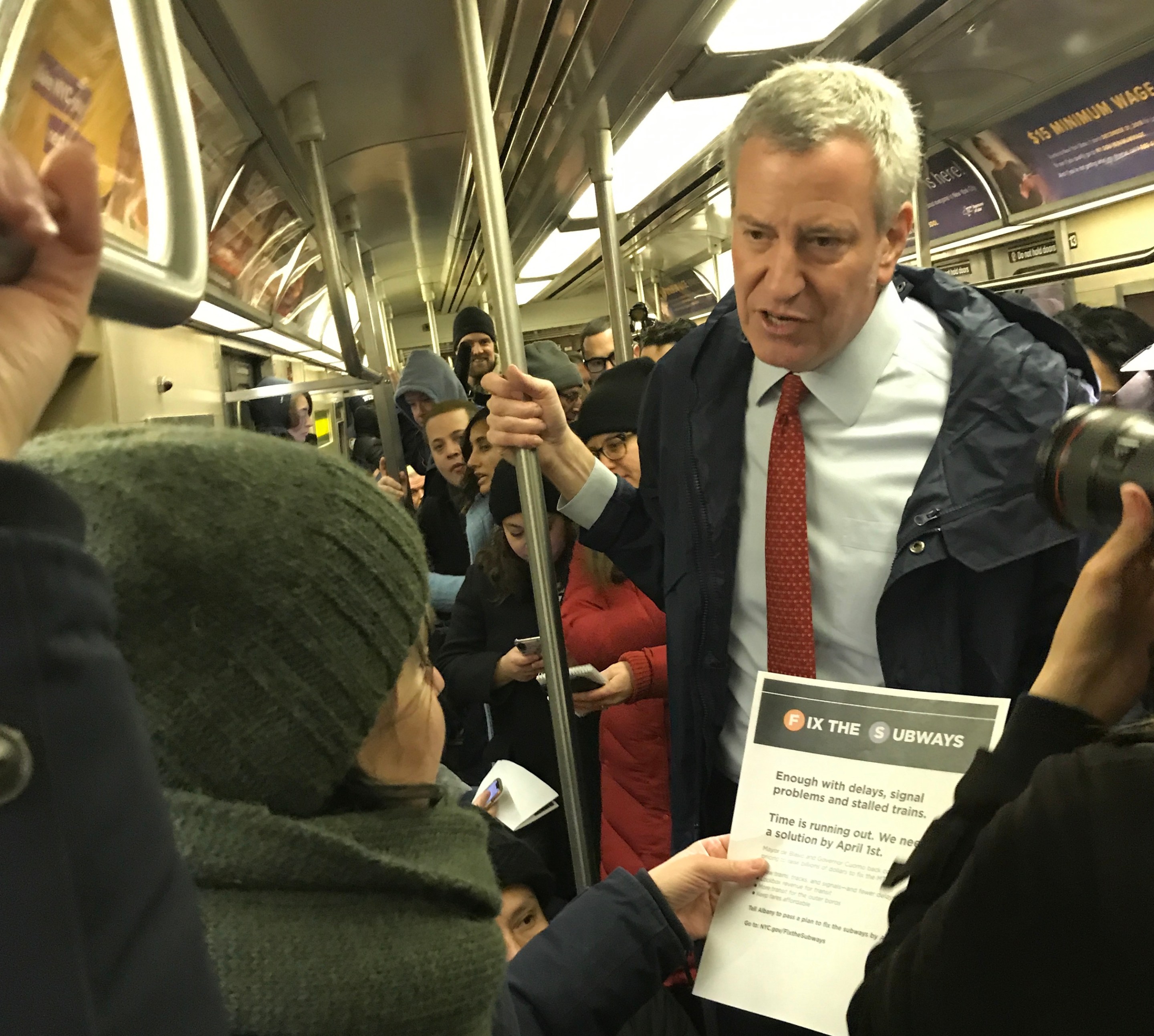Mayor de Blasio strongly pushed back against criticism that he had given over full control of the MTA to Governor Cuomo — indeed, saying that giving the governor more power to run the city's transit network would make the MTA more accountable to the people.
"The equivalent I make is like mayoral control of education — I'd rather have one person in charge and it clearly should be the governor," de Blasio told reporters on Thursday, one day after he offered his full support for congestion pricing as part of a new MTA structure that gives Cuomo more control. "The MTA structure was created to make sure no one was seen to be in charge. This is saying, out loud, [so] everyone understands: gubernatorial control of the MTA. Full accountability. There will be checks and balances, but full accountability. I think that changes everything."
The mayor's comments came after he made a rare appearance on the subway, taking the R train from Park Slope's Ninth Street station to City Hall after his morning workout at the gym. On the train, the mayor pitched his new alliance with the governor, handing out fliers touting a "lockbox" for congestion pricing revenues and "more transit for the outer boros." The mayor's full-throated support for congestion pricing comes after many years of keeping the proposal at arms length.
He said little about the deal that gives Cuomo control, explaining to reporters later that he joined the governor after getting assurances that congestion pricing would prioritize existing transit deserts and would include carveouts for "hardship" cases such as people who claim they need a car to get to medical appointments in Manhattan that are, apparently, unavailable elsewhere or accessible by mass transit. The congestion pricing toll would also give a discount to Manhattan-bound drivers who have already paid the toll at the Battery or Queens-Midtown tunnels [PDF, starting on page 295]
"A lot of folks in Albany are going to appreciate those provisions, which have not been part of previous plans," he said. "So I think for a lot of members [of the legislature] who are now considering it, they're going to see a lot of unity between the governor and I, a much improved plan and they are certainly hearing the urgency from their constituents.
"I totally get why anyone would say, 'What about the notion of the city being in charge?'" the mayor added. "My answer is this plan now is the single best way to answer the problems of our straphangers right now."
The mayor, who often speaks of New York City residents as if they mostly get around by car, shifted his tone a bit on Thursday. Asked by a reporter who typically defends the interests of drivers about why motorists should pay to enter Manhattan, de Blasio said, "This is what all of us in the city of New York need. If we don't fix our subways, the economy won't work and this place can't be what it's supposed to be. Drivers understand that, too. In the end, we have to create something that's fair. Where you see if you're spending more, it achieves something: it fixes the subways and makes sure that places that don't have enough mass transit have it. And that means some of those drivers will have the option of taking mass transit instead."
The mayor's comments came just as some Senate Democrats from Long Island rebelled from the new MTA structure and the current congestion pricing proposal.
"The proposal is heavily, if not exclusively, designed to channel funding to the subway system," Majority Leader Andrea Stewart-Cousins and six Long Island Democrats said in a statement. "If Long Islanders are going to be asked to eschew driving to the city and use the Long Island Rail Road, then there must be a significant investment in LIRR infrastructure to support this endeavor. Therefore, a dedicated revenue stream for Long Island mass transit should be included in the proposal.
“It is our responsibility to ensure that any congestion pricing plan is not funded on their backs without substantial benefit," said the would-be power brokers from the suburbs, John Brooks, Jim Gaughran, Anna Kaplan, Todd Kaminsky, Monica Martinez, and Kevin Thomas.
The group said the proposal "raises troubling concerns," including the fact that drivers who use the Triborough Bridge to access Manhattan would not get a discount if they later enter the congestion pricing zone.
“Clearly, there is a need for a dedicated stream of revenue to fix the crumbling MTA, but any fix must benefit all parts of the MTA," Stewart-Cousins said.
It is a fallacy that LIRR riders are subsidizing city straphangers or not getting their fair share of MTA resources, as many experts pointed out Thursday.
And congestion pricing expert Charles Komanoff snarked the Long Islanders in a tweet.
So the LI Senate Majority delegation insists that "a dedicated revenue stream for LI mass transit be included in the [congestion pricing] proposal." By my estimate., Nassau & Suffolk residents will kick in 8% of c.p. revenues. Are the senators okay with LIRR getting 8% of c.p. $? pic.twitter.com/0UF5vYf3il
— Charles Komanoff (@Komanoff) February 27, 2019







